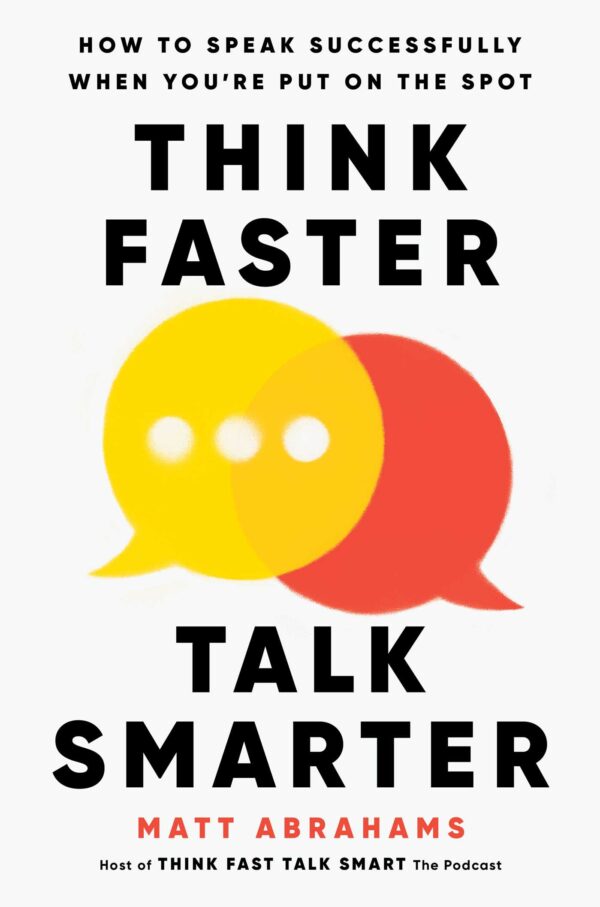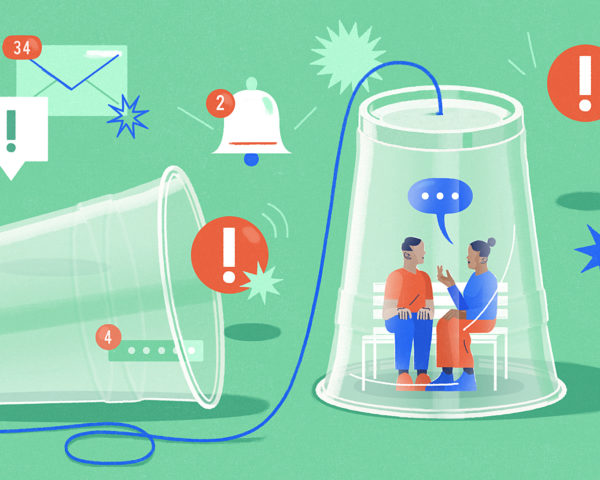10 lessons to unlearn for better communication at work
Communication consultant Matt Abrahams flips conventional wisdom on its head, sharing tips and tricks for better thinking (and speaking) on your feet.
Imagine your very best professional self – the most confident, well-spoken version of you. How does that version of you communicate as they move through the world?
Let’s say you were unexpectedly called to a stage, for a TED Talk-style presentation. You’re effortlessly confident as you stride up in front of the crowd. You know exactly what to say, and you never trip or stumble over your words.
Well, we’ve got news for you – this isn’t reality.
Absolutely no one communicates this way on their feet – not even professional public speakers. Those seemingly effortless TED Talks are highly scripted, carefully staged, and sometimes edited after the fact.
And that’s good news! You don’t need to be a superhuman to communicate well at work (or anywhere else, for that matter).

In his forthcoming book Think Faster, Talk Smarter, Stanford lecturer, communication consultant, and Think Fast Talk Smart podcast host Matt Abrahams explains how anyone can become an exceptional spontaneous communicator – whether answering questions, giving feedback, making small talk, or giving a wedding toast.
The book shares strategies Abrahams has honed over his career, and surprisingly, many of them contradict deeply ingrained ideas we hold about how to communicate well. If you’re willing to “deprogram” some conventional communication advice, you too can become a better spontaneous speaker.
We talked to Abrahams about how to think faster and talk smarter when you’re winging it, whether your audience is a few colleagues on Zoom, your family and friends, or an auditorium full of people. Here are ten strategies to unlearn for better communication:
If it isn’t perfect, it’s not worth saying.
Most of us have been taught since childhood to do the best we possibly can. In most situations, that’s good advice – but it’s not how spontaneous communication works.
When we pressure ourselves to be perfect, we strain our cognitive abilities. We’re focused on ourselves, rather than the situation at hand and how to respond to it. Ironically, that ends up harming our performance.
Instead, give yourself permission to be merely satisfactory. Don’t fear the ordinary or the sufficient; in most cases, “good enough” is great! You don’t need to come up with the Next Big Idea, or be the genius in the room.
“I like to say, ‘strive for mediocrity so you can achieve greatness,’” says Abrahams. “When you focus on just getting your communication done, you free up the cognitive resources to do it well. We need to dial back our desire to do it ‘right,’ because ‘right’ doesn’t even exist.”
When you stop chasing perfection, you’re more likely to communicate from a relaxed, intuitive place. That makes it so much more likely you’ll have an authentic connection with whoever you’re speaking to – and in spontaneous speaking, connection, not perfection, is always the goal.
If you’re nervous, you’re underprepared.
Nerves are a normal, human response to high-stakes situations. Anxiety is not an indication you’ll fail – there’s even some evidence it can improve your performance.
Accepting all your feelings, nerves and all, is a form of mindfulness. If you acknowledge and accept your anxiety, you gain a sense of agency and give yourself space to do something about it. That makes it much less likely to distract you or derail your communication.
strategies to manage anxiety
- Relieving physical symptoms: chewing gum if your mouth gets dry, or holding a cold water bottle if you blush easily
- Intentionally slowing down your movements and breathing deeply
- Preparing affirmations, like “my perspective is valuable,” or “anxiety doesn’t mean something’s wrong.”
Find a few trusty phrases to use over and over again.
Have you ever found yourself repeating “It’s all gonna be okay” when comforting an upset friend? Have you blurted out the dreaded “It is what it is” in an unfortunate situation?
We all have go-to phrases we like to fall back on. The technical term for these mental shortcuts is heuristics, and we revert to them when we’re anxious, depleted, or don’t have time to think.
Common heuristics might include:
- “I get where you’re coming from,” on receiving negative feedback
- “I’ll take that into account,” when others share their ideas
- “Did you check in the Drive folder?” on being asked for help finding a document
- “Let me know if you have any questions,” to close a presentation or email
Heuristics do serve us in some ways, but they also limit the insightfulness and creativity of our communication. By definition, these are generalized, widely applicable statements – not responses to the unique situations we find ourselves in. Heuristics lock you into a way of thinking and acting that doesn’t leave room for you to do what’s needed in the moment.
To overcome your dependency on heuristics, get to know your own communication tropes and the situations that tend to trigger them. This self-awareness lets you know when you’re likely to revert to these mental shortcuts. That lets you pause, slow down, and pay close attention to the person and situation, so you can come up with a considered, original response.
Treat spontaneous communication like a performance.
When you’re communicating at work, you might feel like all eyes are on you. You need to deliver an impactful performance, curating each word and sentence to that end.
Actually, it’s better to take the opposite approach. Treat communications like a conversation, not a performance – even when you are in front of a crowd.
The core of this idea is to shift your focus away from yourself, and onto whoever you’re addressing. Focus on listening over speaking, asking more questions, and using less formal language. Don’t be afraid of natural repetition and pauses, either.
These techniques work for public speaking, too. Pay close attention to your audience during a speech – are they shifting in their seats, or paying rapt attention? Does it make sense to structure a presentation by asking conversational questions, then answering them yourself?
In high-stakes situations, the safest bet is to prepare a script.
When the pressure is on, like in a job interview, it’s tempting to plan out exactly what you’ll say. You don’t want to mess up, so why leave anything up to chance?
But if you stick to a memorized script, you lose the ability to listen and respond in the moment. And remembering and reciting text depletes your cognitive capacity. It forces you to be self-focused, not other-focused – and that’s crucial for connecting with your audience in a meaningful way.
Instead, aim to be present, relaxed, and attentive. You can still prepare by thinking about general topics or questions you’re likely to run into. But you won’t be racking your brain for canned answers, or drawing a blank when the conversation veers off-script. Try deciding on your general structure and core message, without preparing a word-for-word script.
To communicate efficiently, list off your key takeaways.
When you know you’re on the hook to deliver an important message, you’ll probably want to do some planning. You might note down some important points – ones you need to be sure not to miss.
That’s not a bad way to prepare, but let it stay in the brainstorming stage. Good communication does need some structure – you don’t want to drift off into a tangent. But when your message is just a pre-packaged list of unrelated points, it’s hard for audiences to see the big picture.
Instead, use narrative-style frameworks to guide your spontaneous communications. Narrative structure presents your message as a beginning, middle, and end, naturally flowing into one another.
Useful narrative structures
- What–So What–Now What
- The topic, why it matters, and what follows
- How you could use it when giving feedback:
- What: “You spoke quickly, with few details, when you covered the implementation plan.”
- So what: “When you speak quickly, without specificity, it makes you seem unprepared.”
- Now what: “Next time, please slow down and include the example from the accounting team.”
- Problem–Solution–Benefit
- The challenge, how your product or idea solves it, the final outcome
- How you could use it when requesting more resources:
- Problem: “Half of our team is spending time fixing bugs instead of developing new code.”
- Solution: “By investing in the new AI code review tool, we can reduce bugs before we submit our final code.”
- Benefit: “We can save money, increase quality, and get new code out faster.”
- PREP (Point–Reason–Example–Point)
- Your point, the reasoning behind it, concrete examples, the point again
- Here’s how you could use it when explaining a new feature:
- Point: “This feature lets us more easily authenticate users.”
- Reason: “It reduces frustration and makes the process faster.”
- Example: “For example, you now only need to log in once.”
- Point: “This new authentication process makes users’ and developers’ lives easier.”
Never get caught without something to say.
It doesn’t make you look bad to pause and reflect. It makes you look like a human being who cares about and holds space for others.
Don’t be afraid to slow down, or even be silent for a moment as you’re communicating. Remember, it’s a conversation, not a performance.
This slower pacing allows you to actively listen to the other person, and process what they have to say. It also gives you space for improvisation, so you can get away from heuristics and share genuine, in-the-moment responses.
There are three components to this attentive, active listening – pace, space, and grace.
- Slow your pace: Take your time and embrace pauses, especially when asking and answering difficult questions.
- Make space for reflection: Build in time to reflect and process what’s been shared – even if it means continuing the conversation later.
- Give yourself grace: Listen to your own internal dialogue, not just to the other person. Do you notice yourself thinking “I’m not sure about that,” or “What about…?” Honor that voice by asking clarifying questions.
Optimize your message to convey as much information as possible.
More information isn’t always better – in fact, too much is a communication killer.
Instead, focus on the core message you want your audience to grasp. Consider removing any detail that’s not critical to understanding that message.
Think about what your audience already knows and cares about when you’re deciding how much to share. For example, technical product details won’t help an audience who doesn’t have technical knowledge. If you must explain a complex idea, use more familiar analogies and examples to make it easier to grasp.
Let’s take Google’s mission statement as an example. The company offers many highly complex, sophisticated products, but their mission statement is simple: “to organize the world’s information and make it universally useful and accessible.”
This statement doesn’t mention the technology behind Google’s products, or even the individual products themselves. And yet, it tells us exactly what the company does.
In a disagreement, the best offense is a strong defense.
When someone doesn’t agree with you, immediately jumping into defensive mode primes a situation for conflict. Instead, start by finding common ground. What do you agree on? How can you move forward from there?
You can also consider responding with questions. Turn the asker’s question back on them to understand their perspective – what would they do in your position? Or, ask them to clarify what they meant.
“The people most critical of your point of view are exactly who you want to engage,” explains Abrahams. “They at least care about what you are saying. It’s the people who are apathetic that are the real challenges.”
It’s natural and inevitable for your ideas to be challenged occasionally! This is how we collaborate and find new, creative solutions, especially in the workplace.
Avoid mistakes at all costs.
Your career isn’t over if you make a mistake, and no one is hoping for you to fail.
Instead, think of mistakes as “missed takes.” If a Hollywood film director needs a few tries to get the right shot, why should your communications be bang-on every time?
When you do slip up, don’t overfocus on the error – all that’s doing is slowing you down and distracting from your core message. Instead, quickly acknowledge it and move on to what’s next. You can always follow up with a personal, thoughtful apology later.
At the end of the day, “The goal of communication is to connect, collaborate, and engage,” Abrahams says. “That means we need to be present, agile, and open.”
Anyone can get better at spontaneous communication. According to Abrahams, all it takes is repeated practice, a willingness to accept feedback, and plenty of reflection on your existing communication patterns.
But whether you’re a natural leader or a complete introvert, you must first adjust your mindset. That means unlearning commonly-held ideas that might be holding you back from thinking faster and talking smarter.
The Think Faster, Talk Smarter book, eBook, and audio book are available on September 26, 2023. You can pre-order or order here. Further, you can connect with Matt via LinkedIn and find resources at his website.












































